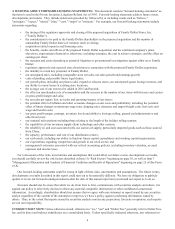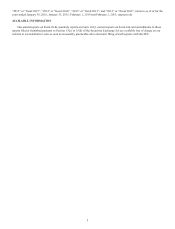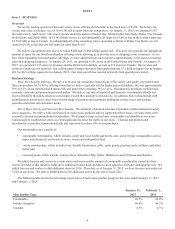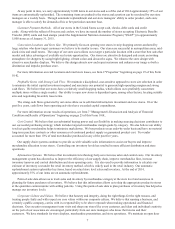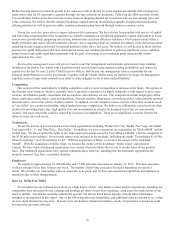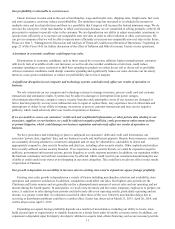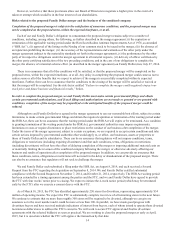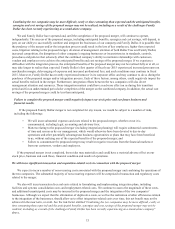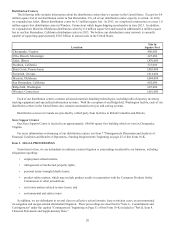Dollar Tree 2014 Annual Report Download - page 27
Download and view the complete annual report
Please find page 27 of the 2014 Dollar Tree annual report below. You can navigate through the pages in the report by either clicking on the pages listed below, or by using the keyword search tool below to find specific information within the annual report.11
Our profitability is vulnerable to cost increases.
Future increases in costs such as the cost of merchandise, wage and benefit costs, shipping rates, freight costs, fuel costs
and store occupancy costs may reduce our profitability. The minimum wage has increased or is scheduled to increase in
multiple states and local jurisdictions and there is a possibility that Congress will increase the federal minimum wage. We do
not raise the sales price of our merchandise to offset cost increases because we are committed to selling primarily at the $1.00
price point to continue to provide value to the customer. We are dependent on our ability to adjust our product assortment, to
operate more efficiently or to increase our comparable store net sales in order to offset inflation or other cost increases. We
can give no assurance that we will be able to operate more efficiently or increase our comparable store net sales in the future.
Please see Item 7, “Management’s Discussion and Analysis of Financial Condition and Results of Operations,” beginning on
page 25 of this Form 10-K for further discussion of the effect of Inflation and Other Economic Factors on our operations.
A downturn in economic conditions could impact our sales.
Deterioration in economic conditions, such as those caused by a recession, inflation, higher unemployment, consumer
debt levels, lack of available credit, cost increases, as well as adverse weather conditions or terrorism, could reduce
consumer spending or cause customers to shift their spending to products we either do not sell or do not sell as profitably.
Adverse economic conditions could disrupt consumer spending and significantly reduce our sales, decrease our inventory
turnover, cause greater markdowns or reduce our profitability due to lower margins.
A significant disruption in our computer and technology systems could adversely affect our results of operation or
business.
We rely extensively on our computer and technology systems to manage inventory, process credit card and customer
transactions and summarize results. Systems may be subject to damage or interruption from power outages,
telecommunication failures, computer viruses, security breaches and catastrophic events. If our systems are damaged or
fail to function properly, we may incur substantial costs to repair or replace them, may experience loss of critical data and
interruptions or delays in our ability to manage inventories or process customer transactions and may receive negative
publicity, which could adversely affect our results of operation or business.
If we are unable to secure our customers’ credit card and confidential information, or other private data relating to our
associates, suppliers or our business, we could be subject to negative publicity, costly government enforcement actions
or private litigation, which could damage our business reputation and adversely affect our results of operation or
business.
We have procedures and technology in place to safeguard our customers’ debit and credit card information, our
associates’ private data, suppliers’ data, and our business records and intellectual property. Despite these measures, criminals
are constantly devising schemes to circumvent safeguards and we may be vulnerable to, and unable to detect and
appropriately respond to, data security breaches and data loss, including cyber-security attacks. Other sophisticated retailers
have recently suffered serious security breaches. If we experience a data security breach, we could be exposed to negative
publicity, government enforcement actions, private litigation, or costly response measures. In addition, our reputation within
the business community and with our customers may be affected, which could result in our customers discontinuing the use
of debit or credit cards in our stores or not shopping in our stores altogether. This could have an adverse effect on our results
of operation or business.
Our growth is dependent on our ability to increase sales in existing stores and to expand our square footage profitably.
Existing store sales growth is dependent on a variety of factors including merchandise selection and availability, store
operations and customer satisfaction. In addition, competition could affect our sales. Our highest sales periods are the
Christmas and Easter seasons and we generally realize a disproportionate amount of our net sales and our operating and net
income during the fourth quarter. In anticipation, we stock extra inventory and hire many temporary employees to prepare our
stores. A reduction in sales during these periods could adversely affect our operating results, particularly operating and net
income, to a greater extent than if a reduction occurred at other times of the year. Untimely merchandise delays due to
receiving or distribution problems could have a similar effect. Easter was observed on March 31, 2013, April 20, 2014, and
will be observed on April 5, 2015.
Expanding our square footage profitably depends on a number of uncertainties, including our ability to locate, lease,
build out and open or expand stores in suitable locations on a timely basis under favorable economic terms. In addition, our
expansion is dependent upon third-party developers’ abilities to acquire land, obtain financing, and secure necessary permits





